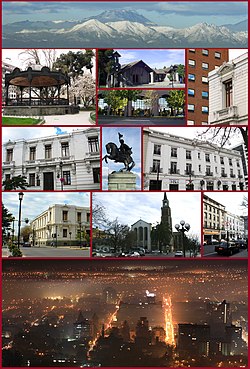Talca | |
|---|---|
 1º row: Andes mountains in Talca. 2º row: (left) Town square of Talca, (centre-top) Catholic University of the Maule, (centre-down) Ancient Library of the University of Talca, (right) architectural contrasts. 3º row: Old Intendancy of Maule, statue of Bernardo O'Higgins, BCI Bank. 4º row: 1 Norte street, St. Augustine Cathedral, and 1 Sur street. 5º row: Nocturnal cityscape of Talca. | |
| Coordinates: 35°25′37″S 71°39′56″W / 35.42694°S 71.66556°W | |
| Region | Maule Region |
| Province | Talca Province |
| Founded | May 12, 1742 |
| Government | |
| • Type | Municipality |
| • Alcalde | Juan Carlos Díaz Avendaño |
| Area | |
| • Total | 231.5 km2 (89.4 sq mi) |
| Elevation | 102 m (335 ft) |
| Population (2015 Census)[4] | |
| • Total | 233,339 |
| • Density | 1,000/km2 (2,600/sq mi) |
| Demonym | Talquino |
| Sex | |
| • Men | 111,796 |
| • Women | 121,543 |
| Time zone | UTC−4 (CLT) |
| • Summer (DST) | UTC−3 (CLST) |
| Postal code | 3460000 |
| Area code | 56 (country) + 712 (Talca Province) |
| Climate | Csb |
| Website | talca |
Talca (Spanish pronunciation: [ˈtalka]) is a city and commune in Chile located about 255 km (158 mi) south of Santiago, and is the capital of both Talca Province and Maule Region (7th Region of Chile). As of the 2012 census, the city had a population of 201,142.
The city is an important economic center, with agricultural (wheat) and manufacturing activities, as well as wine production. It is also the location of the Universidad de Talca and the Catholic University of Maule, among others. The Catholic Church of Talca has held a prominent role in the history of Chile.
- ^ "Municipality of Talca" (in Spanish). Retrieved January 22, 2010.
- ^ "Asociación Chilena de Municipalidades" (in Spanish). Archived from the original on April 19, 2011. Retrieved January 22, 2010.
- ^ "National Statistics Institute" (in Spanish). Retrieved July 28, 2010.
- ^ a b "National Statistics Institute" (in Spanish). Retrieved April 28, 2017.


